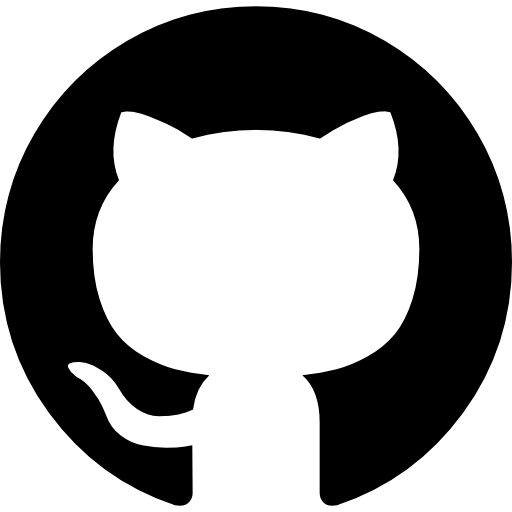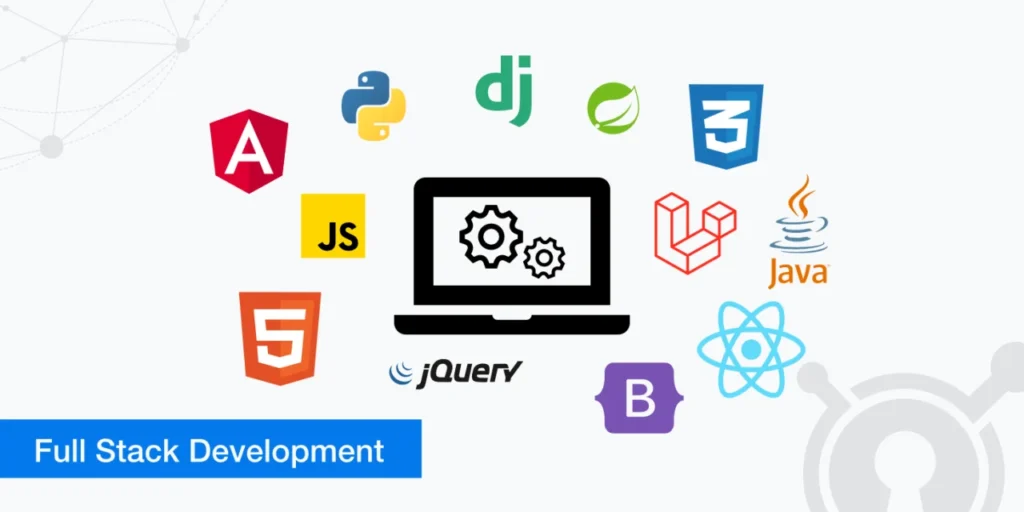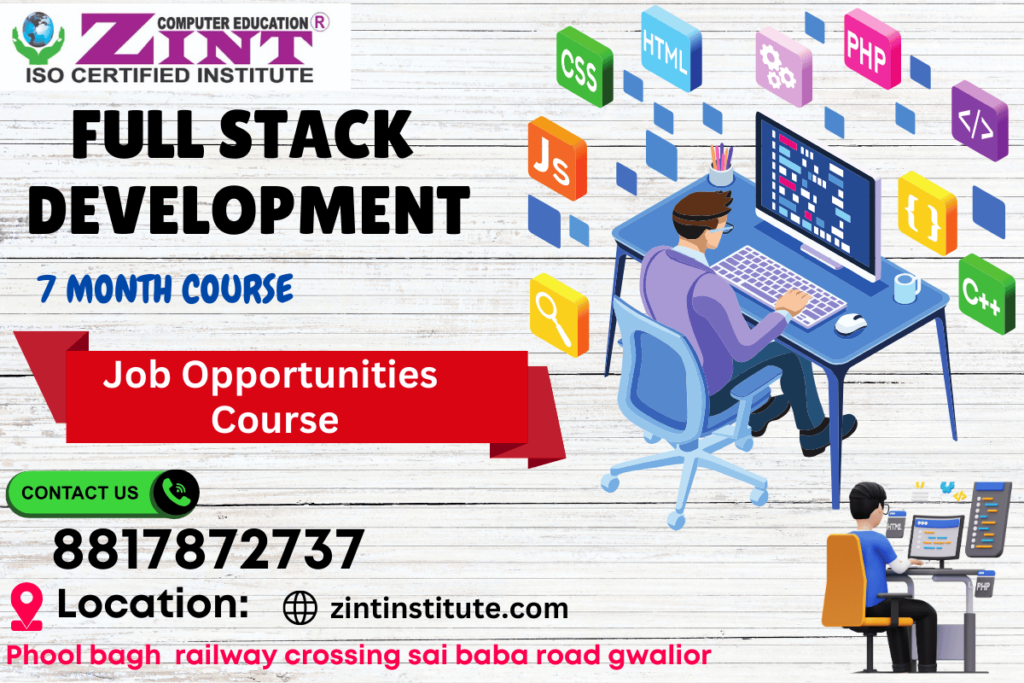
COURSE DEATAIL
Front-end development
HTML
CSS
BOOTSTRAP
JAVA SCRIPT
REACT JS
ANGULAR
Back-end development
NODE. JS
EXPRESS JS
JAVA
PYTHON
PHP
RUBY
DJANGO
Database
SQL
Mysql
MONGO DB
What Is a Full-Stack Developer?
A full-stack developer is a professional skilled in both front-end and back-end development, enabling them to build and manage complete websites or web applications. The front end refers to the user-facing parts of a website, while the back end involves the server-side operations, including data storage and processing. Full-stack developers possess a diverse skill set, allowing them to oversee the entire development process effectively.
They may work in-house for a company or with software development firms that create websites, applications, and other digital solutions for various businesses.
Tools Covered




Hubspot
VS code
Figma
Codepen
Github
Hubspot
Front-End Development-:
Front-end development focuses on building the interface and visual aspects of a website. This involves:
- Coding interactive features such as drop-down menus.
- Designing page layouts, fonts, and color schemes.
- Ensuring a visually appealing and user-friendly experience.
Full-stack developers must be proficient in HTML, CSS, and JavaScript, among other technologies, to create engaging websites and applications. If you’re transitioning from back-end to full-stack development, consider enhancing your front-end expertise with certifications, such as Meta’s Professional Certificate in Front-End Development.
Back-End Development-:
Back-end development involves managing the logic, algorithms, and data processing behind a website. Skills required include:
- Proficiency in programming languages like Python or Java
- Understanding algorithms and business logic
- Managing databases and web storage
To build robust back-end systems, a full-stack developer must also know how to design, manipulate, and query databases.
Enhancement Tip: Upgrade your back-end development skills by pursuing certifications like Meta’s Back-End Developer Professional Certificate to prepare for a full-stack role.
Database Management-:
Database management is a crucial skill for full-stack developers, forming an integral part of back-end web development. A full-stack developer must be capable of designing, understanding, and managing database queries as well as handling web storage effectively.
To succeed in this area, familiarity with the following programming languages and tools is essential:
- SQL and NoSQL databases (e.g., MySQL, MongoDB)
- Database query optimization
- Web storage mechanisms (e.g., local storage, session storage)
These skills enable full-stack developers to efficiently manage data and ensure the smooth operation of web applications.
.
Lottie widget with custom count loop
You can now use Lottie widget with a custom count loop. Turn your boring static elements into beautiful animated elements with few clicks.
Why Pursue a Career in Full-Stack Development?
A career in full-stack development offers the perfect blend of creativity and analytical thinking. As a full-stack developer, you have the opportunity to work on both the front-end and back-end of applications, providing a comprehensive view of the development process.
Key reasons to choose full-stack development include:
Diverse Skill Set: Mastering both front-end and back-end technologies makes you a versatile professional.
High Demand: Companies value developers who can handle multiple layers of a project, making full-stack developers highly sought-after.
Innovative Work: You’ll have the chance to learn and apply cutting-edge technologies and principles in your projects.
Creative Freedom: Combining design and functionality allows you to create user-friendly, visually appealing applications.
Career Growth: The role offers multiple pathways for advancement, from specialized development roles to leadership
Frontend development
Back-End Devlopment
DAtabase Management

Full Stack Developer Curriculum
HTML5 – Hypertext Markup Language
- CSS3 – Cascading Style Sheets
- JavaScript (ECMAScript 2023)
- jQuery & jQuery UI (v3.6.0)
- Bootstrap (v5.3.0)
- AJAX
- AngularJS
- Logo Desine

Front-end development Coures Module-:
1. HTML
- HTML Basics
- HTML Elements
- HTML5 Semantic
- HTML Attributes
- HTML Headings
- HTML Paragraph
- HTML Styles
- HTML Formatting
- HTML Quotations
- HTML Computer Code
- HTML Comments & Colours
- HTML CSS, Links and Images
- HTML Lists
- HTML Blocks
- HTML Classes
- HTML Layout
- HTML Responsive
- HTML iframes
- HTML JavaScript
- HTML Head
- HTML Entities and URI Code
- HTML Symbols and XHTML
- HTML Charset and Forms
2. CSS3
- CSS3 Syntax
- CSS3 How To
- CSS3 Colours
- CSS3 Backgrounds
- CSS3 Boarders
- CSS Padding
- CSS Height/Width
- CSS3 Gradients
- CSS3 Shadows
- CSS3 Text
- CSS3 Fonts
- CSS3 2D Transforms
- CSS3 3D Transforms
- CSS Links
- CSS Lists
- CSS Tables
- CSS Box Model
- CSS Outline
- CSS Display
- CSS Max-width
- CSS Position
- CSS Float
CSS Inline-block
- CSS Align
- CSS Combinators
- CSS Pseudo-class
- CSS Pseudo-element
- CSS Navigation Bar
- CSS Dropdowns
- CSS Tooltips
- CSS3 Images
- CSS Attr Selectors
- CSS Forms
- CSS Counters
- CSS3 Animations
- CSS3 Buttons
- CSS3 Pagination
- CSS3 Multiple Columns
- CSS3 User Interface
- CSS3 Box Sizing
- CSS3 Filters
- CSS3 Media Queries
- CSS3 Responsive

Javascipt Course
1. JavaScript
- Problem solving – what?
- Introduction to SDLC
- Polya’s rules
- Algorithm design methods
- Pseudo code creation
- Flowcharts
2. Core JavaScript Concepts
- History of JavaScript
- Advantages
- Limitations
- Script element
- Creating your first JavaScript program
- Coding convention
- Setting up development environment (with VSCode)
3. Types and Statements
Keywords in JavaScript
- Overview of Data types
- Primitive Data types
- Non-primitive Data types
- Conditional statements
- I/O in JavaScript loops
4. Operators
- Introduction to operators
- Operator precedence and associativity
- Deep dive into operators
- Arithmetic
- Comparison
- Ternary
- Logical
- Language
- Bitwise
5. Functions - Level I
- Introduction to functions
- Function definition
- Passing values
- Returning values
- Robust parameter handling
- Local and global variables
- Functions as objects
- Function constructor
6. Functions - Level II
- Function invocation patterns
- Recursion functions
- Generator functions
- Arrow functions
- Variadic functions
- JavaScript scopes
- Function closures
7.Arrays and Strings
- Introduction to Arrays
- Array declaration
- Array access methods
- Multi-dimensional arrays
- String properties
- String access methods
8. Regular Expressions
- Introduction to RegExp
- Regular expression usage
- Modifiers
- RegExp patterns
- RegExp methods
- String methods for RegExp
- Type conversion in JavaScript
9. Objects in JavaScript
- Introduction to objects
- Type of objects in JavaScript
- Creating objects
10. Object methods
• Constructor function
• Prototype in JavaScript
• Inheritance using prototype chain
11. Event handling
• JavaScript events
• Event handler
• Event flow
• Event bubbling and capturing
• Event listeners
• Event types
12. Document Object Model (DOM)
• Introduction to DOM
• Types of DOM
• DOM standards and methods
• Manipulating documents using DOM
• Handling images
• Table manipulate
13. Browser Object Model
• Introduction to BOM
• DOM vs BOM differences
• Window object and methods
• BOM navigator
•BOM history
• BOM location
• BOM timer
• Introduction to Cookies
• Session and persistent cookies
14. Form Handling
• Introduction to forms
• Form processing
• Forms object
• Accessing data from forms
• Form validation
• Additional features in forms
• Validation APIs
15. Debugging Techniques
• JavaScript Errors
• Error handling mechanisms
• Introduction to Google Chrome debugger
• Deep dive into debugger window
• Introduction to Breakpoints
• Changing variable values in runtime
• Avoiding mistakes

Full Stack Developer Curriculum
1. JQUERY
JQUERY
- Introduction to jQuery
- jQuery Syntax
- jQuery Selectors
- jQuery Events
- jQuery Effects
- jQuery HTML
- jQuery Traversing
- jQuery AJAX
- jQuery Misc.
2. Bootstrap
- Introduction to Bootstrap
- Bootstrap Basics
Bootstrap Grids
- Bootstrap Themes
- Bootstrap CSS
- Bootstrap JS
3. AJAX
Introduction to Ajax
- Ajax Framework and CLR
- Introduction to Visual studio
Introduction to C#
- Overview of C#
- Data Types
- Memory Concepts
- Control Structures
- Arrays
- Namespaces
Developing an application using Ajax and MySQL
- Previous and Next Browsing
- Inserts, Updates, and Deletes
- Querying a database
- User-Driven Querying
- User Authentication and Management
- Ordering and Shipping
- MySQL functions in Ajax
Ajax Project Work
- Development using Ajax/MySQL
- Deployment
- Coding Documentation
- Unit Testing
Three tier architecture for course module
- Client tier
- Middle tier
- Database tier
Case Study for Ajax/MySQL
- Populating Web pages from a database
- Data Entry and Validation
- User Authentication and Management
- Reporting
User-driven queries/browse
4. ANGULAR JS
Angularjs Course Content
- AngularJS Training Overview
- AngularJS Training Objectives
- Who should do the course
- Prerequisites for Angular JS Course
- Angular JS Course Content
- AngularJS Introduction
- Execution flow
- Controllers
- Bootstrapping Angular APPS
- Data Binding
- Understanding AngularJS Architecture
- Dependency Injection
- Expressions
- Directives
- Filters
- Events
- Modules
- AngularJS XMLHttpRequest (AJAX)
- AngularJS Forms & Input Validation AngularJS Service Types
- Single Page Applications
- REST API Calls
- Animations
- Angular with UI Frameworks
- Behavior Driven Development
- Angular with UI Frameworks
- Behavior Driven Development
React JS Course Syllabus

React JS Course Information
React JS
SECTION 1: WHAT IS REACT JS?
➢ React JS Introduction
➢ Advantages of React JS
➢ Work flow of React JS
➢ Scope of React JS
SECTION 2: OVERVIEW OF JSX
➢ Introduction of Virtual DOM.
➢ Difference between JS and JSX.
➢ React Components overview
➢ Containers and components
➢ What is Child Components?
➢ What is Namespaced components?
➢ What are the JavaScript expressions available in JSX?
SECTION 3: REACT JS ENVIRONMENT SETUPS
➢ Node setup
➢ How to use NPM?
➢ How to create package.json and purpose of it?
➢ ES6 Introduction and features.
www.credosystemz.com
➢ Webpack Overview
➢ Best IDE for React JS and How to write optimized code in React JS?
➢ React JS browser plugins overview.
Real-time Practicals
- NPM Installation by locally and Globally
- Create a Basic App with React JS and other Supported NPM
SECTION 4: A REAL-TIME APPLICATION BY USING REACT JS
➢ Create a React component with JSX template.
➢ How to create Nested Components?
➢ What is React JS render?
➢ React Props overview.
➢ Introduction of Props validation with data types.
➢ Flow of States, Initialize states and update states.
Real-time Practical’s
- Create a Small React Module
- Use All the states in in the created Application.
SECTION 5: REACT JS FORMS AND UI
➢ Lists of Form components.
➢ Setup Controlled and Uncontrolled form components.
➢ Control Input elements.
➢ How to set default values on all formats of Input elements.
➢ React JS Form validations.
➢ How to write Styles?
➢ Animations overview
www.credosystemz.com
Real-time Practicals
- Create a React Form.
- Client-side form validation.
- Applying form components.
- Submit and Rest the form.
SECTION 6: REACT JS COMPONENT LIFE CYCLES OVERVIEW
➢ Initial Render
➢ Props Change
➢ Stage Change
➢ Component willMount
➢ Component didMount
➢ Component Unmount
Real-time Practicals
- Applying Different Lifecylces in the Application.
- When to choose Appropriate lifecycles.
SECTION 7: ROUTING IN REACT JS AND OTHER JS CONCEPTS
➢ Single Page Application Overview.
➢ How to configure React Router?
➢ History of Router
➢ How to Handle Conditional statement in JSX?
➢ IIFE in JSX for complex logic overview.
Real-time Practicals
- Create a Single Page Application.
- Applying Routing.
- Dynamically render the components based on the url.
www.credosystemz.com
SECTION 8: EVENT HANDLING IN JSX
➢ onBlur, onKeyUp, onChange and other useful primary events in React JS.
➢ How to Sharing events between the components?
Real-time Practicals
- Communicate Data between components.
- Applying all lists of events.
SECTION 9: HOW TO WRITE STYLES IN REACT JS?
➢ CSS and inline styles in React JS overview.
➢ Introduction to styled components
➢ Real-time Practicals
➢ Styling the application using styled component
➢ How to use Animations in the Application.
SECTION 10: REACT ROUTER WITH NAVIGATION
➢ How to Load the router library?
➢ Configure the React Router?
➢ How to Pass and receive parameters?
➢ Integration of React-cookie overview.
SECTION 11: FLUX , REDUX OVERVIEW
➢ What is Flux Architecture?
➢ What are the Flux Components available?
➢ Stores.
➢ Dispatchers.
➢ View Controllers.
➢ Actions.
➢ Views.
www.credosystemz.com
➢ How Flux works?
➢ Flux and React works together.
➢ Introduction to One Store.
➢ Provider Component
➢ Actions.
➢ Reducers.
➢ sagas
➢ Dispatchers
➢ View Controllers
➢ Selector
Real-time Practicals
- Redux application Development with Real-time Project
SECTION 12: UNIT TESTING OVERVIEW
➢ What are the necessary Tools required for Unit Testing?
➢ React Unit Testing overview
➢ Introduction to JEST.
➢ How to Test React Component?
➢ How to Test React Router?
SECTION 13: INTEGRATION WITH OTHER LIBRARIES
➢ Gulp & Browserify
➢ React with jQuery
➢ React & AJAX
SECTION 14:REACT SERVER INTEGRATION & DEPLOYMENT
➢ https
www.credosystemz.com
➢ httpster
➢ npm
SECTION : 15 HOOKS
➢ Understanding Hooks
➢ The useState hook
➢ Side effects using the useEffect hook
➢ The useContext hook
➢ The useReducer hook
➢ Writing your own hook
SECTION 16: CODE SPLITTING
➢ Code splitting & Suspense
➢ Route Based Code Splitting
➢ Lazy Loading
SECTION 17: ISOMORPHIC REACT
➢ Server Side Rendering
➢ SSR with React – Setup & Server
➢ SSR with React – The Toolchain
SECTION 18: TESTING COMPONENT
➢ Using Jest with Test Utils from React-DOM
➢ Using Jest with the React Testing Library
➢ Using Jest with Enzyme
SECTION 19: EPILOGUE
➢ The React ecosystem
SECTION 20: NEW FEATURES OF REACT 16
www.credosystemz.com
➢ Handling exceptions in components
➢ Error boundaries
SECTION 21: WEBPACK PRIMER AND ISOMORPHIC REACT
➢ Webpack and its use
➢ Setting up and installing Webpack
➢ Working with the configuration file of Webpack
➢ Working with loaders
➢ Quick word on lazy loading, code splitting, and tree shaking
➢ Setting up a hot module replacement
➢ Server-side rendering (SSR)
➢ Working with renderToStaticMarkup and renderToString methods
SECTION 22: FETCH DATA USING GRAPHQL
➢ What is GraphQL?
➢ Cons of Rest API
➢ Pros of GraphQL
➢ Frontend backend communication using GraphQL
➢ Type system
➢ GraphQL datatypes
➢ Modifiers
➢ Schemas
➢ GraphiQL tool
➢ Express framework
➢ NPM libraries to build server side of GraphQL
➢ Build a GraphQL API
➢ Apollo client
➢ NPM libraries to build client side of GraphQL
➢ How to setup Apollo
JavaScript Course Syllabus
➢ Introduction
➢ What is JavaScript?
➢ JavaScript Features
➢ JavaScript Libraries
➢ Understanding HTML, CSS, JavaScript
➢ JavaScript Version
➢ ES5
➢ ES6/ES2015
➢ ES7/ES2016
➢ ES8/ES2017
➢ Data Types
➢ Number
➢ String
➢ Boolean
➢ Undefined
➢ Null
➢ Variable Mutation
➢ Basic Operator
➢ Operator Precedence
➢ Shorthand operator
➢ Problem statement
➢ Decision making statement-if else
➢ if else – example
➢ Comparing the problem statement solution
➢ Switch statement – example
➢ Boolean logic
Boolean logic example
➢ Ternary operator
➢ Ternary operator example
➢ Tips
➢ Functions
➢ Function statement
➢ Function Statement Example
➢ What is Array
➢ Real world Problem Ecommerce
➢ Real world problem transport
➢ Space and the Complexity
➢ Built in function Complexity
➢ examples of Array
➢ Objects, When to use it
➢ Objects and Methods
➢ Loops and Iteration
➢ For Loop
➢ Continue and Break Statement
ES6 JavaScript Course Syllabus
➢ History of JavaScript
➢ Features
➢ let & const and its example
➢ Arrow Functions
➢ Alternative
➢ Tips and Arrow Functions
➢ Exports and Imports
➢ Tips for exports and imports
➢ Classes
Classes example
➢ Inheritance
➢ Spread and rest Parameter
➢ Destructing
client
Back-end development Coures Modules-:
Node JS Training Syllabus
Session 1:
Node JS Modules
- Functions
- Buffer
- Module
- Modules Types
- Core Modules
- Local Modules
- Modules Exports
Session 2:
Node Package Manager
- What is NPM Session 2:
- Installing Packages Locally
- Installing package globally
- Adding dependency in package Json
- Updating packages
Session 3:
Creating Web Server
- Creating Web Server
- Sending Requests
Handling HTTP requests
Session 4:
File System
- Read File
- Writing a File
- Opening a File
- Deleting a File
- Writing a file asynchronously
- Other I/O Operations
Session 5:
Debugging Node JS Application
- Core Node JS Debugger
Session 6:
Events
- Event Emitter class
- Inheriting Events
- Returning event emitter
Session 7:
Express JS
- Configuring Routes
- Working with Express
Session 8:
Serving Static Resources
- Serving Static Files
- Working with Middle Ware
Session 9:
Database Connectivity
- Connecting String
- Configuring
- Updating Records
- Working with Select Command
- Deleting Records
Session 10:
: Project Development
- Development using Node JS
Learn Node.JS from the ground up with our comprehensive Node JS training syllabus and secure your career prospects in the field of web design.





Python Course Syllabus
Introduction-:
· What is Python..?
· A Brief history of Python
· Why Should I learn Python..?
· Installing Python
· How to execute Python proge
Write your first program/li>
Variables & Data Types
· Variables
· Numbers
· String
· Lists ,Tuples & Dictionary
Conditional Statements & Loops
· if…statement
· if…else statement
· elif…statement
· The while…Loop
· The for….Loop
Control Statements
· continue statement
· break statement
· pass statement
Functions
· Define function
· Calling a function
· Function arguments
· Built-in functions
Modules & Packages
· Modules
· How to import a module…?
· Command line arguments
· Packages
· Creating custom packages
Classes & Objects
· Introduction about classes & objects
· Creating a class & object
· Inheritance
· Methods Overriding
· Data hiding
Module 1:
Exceptions Handling
- Errors
- Exception handling with try
- handling Multiple Exceptions
- Writing your own Exception
-
- Modules Exports
Module 2:
File Handling
- File handling Modes
- Reading Files
- Writing& Appending to Files
- Handling File Exceptions
- The with statement
Module 3:
Generators and iterators
- Iterators
- Generators
- The Functions any and all
- With Statement
- Data Compression
Module 4:
Data Structures
- List Comprehensions
- Nested List Comprehensions
- Dictionary Comprehensions
- Functions
- Default Parameters
- Variable Arguments
- Specialized Sorts
Module 5:
Collections
- namedtuple()
- deque
- ChainMap
- Counter
- OrderedDict
- defaultdict
- UserDict
- UserList
- UserString
Module 6:
Python SQL Database Access
- Introduction
- Installation
- DB Connection
- Creating DB Table
- INSERT, READ, UPDATE, DELETE operations
- COMMIT & ROLLBACK operation
- handling Errors
Module 7:
Network Programming
- Introduction
- A Daytime Server
- Clients and Servers
- The Client Program
- The Server Program
Module 8:
Date and Time
- sleep
- Program execution time
- more methods on date/time
Module 9:
Few more topics in-detailed
- Filter
- Map
- Reduce
- Decorators
- Frozen set
- Collections
Module 10:
Regular Expression
- Split
- Working with special characters, date, emails
- Quantifiers
- Match and find all
- character sequence and substitute
- Search method
Module 11:
Threads ESSENTIAL
- Class and threads
- Multi-threading
- Synchronization
- Treads Life cycle
- use cases
Module 12:
Accessing API ESSENTIAL
- Introduction
- Facebook Messenger
- Openweather
Module 13:
USING THE INTERPRETER
How Python Runs Programs
How You Run Programs
Configuration Details
Module Files: A First Look
The Idle Interface
Other Python Ides
Time To Start Coding
Lab Session 1
Module 14:
TYPES AND OPERATORS
- A First Pass
- The ‘Big Picture’
- Numbers
- Dynamic Typing Interlude
- Strings
- Lists
- Dictionaries
- Tuples
- General Object Properties
- Summary: Python’s Type Hierarchies
Module 15:
BASIC STATEMENTS
- General Syntax Concepts
- Expressions
- If Selections
- Python Syntax Rules
- Documentation Sources Interlude
- Truth Tests
- While Loops
- Break, Continue, Pass, And The Loop Else
- For Loops
- Comprehensions And Iterations
- Loop Coding Techniques
- Comprehensive Loop Examples
- Basic Coding Gotchas
- Preview: Program Unit Statements
- Lab Session 3
Module 16:
CLASSES
- Oop: The Big Picture
- Class Basics
- A More Realistic Example
- Using The Class Statement
- Using Class Methods
- Customization Via Inheritance
- Specializing Inherited Methods
- Operator Overloading In Classes
- Namespace Rules: The Whole Story
- Oop Examples: Inheritance And Composition
- Classes And Methods Are Objects
- Odds And Ends
- New Style Classes
- Class Gotchas
- Optional Case Study: A Set Class
- Summary: Oop In Python
- Lab Session 6
Module 17:
DJANGO
- Django Overview
- Django Installation
- Creating a Project
- Usage of Project in depth Discussion
- Creating an Application
- Understanding Folder Structure
- Creating a Hello World Page
- Database and Views
- Static Files and Forms
- API and Security
Module 18:
EXCEPTIONS
- Exception Basics
- First Examples
- Exception Idioms
- Exception Catching Modes
- Class Exceptions
- Exception Gotchas
- Lab Session 7
Module 19:
BUILT-IN TOOLS OVERVIEW
- The Secret Handshake
- Debugging Options
- Inspecting Name-Spaces
- Dynamic Coding Tools
- Timing And Profiling Python Programs
- File Types And Packaging Options
- Development Tools For Larger Projects
- Summary: Python Tool-Set Layers
- Lab Session 7 Continued
Module 20:
SYSTEM INTERFACES
- System Modules Overview
- Running Shell Commands
- Arguments, Streams, Shell Variables
- File Tools
- Directory Tools
- Forking Processes
- Thread Modules And Queues
- The Subprocess And Multiprocessing Modules
- Ipc Tools: Pipes, Sockets, Signals
- Fork Versis Spawnv
- Larger Examples
- Lab Session 8
Module 21:
GUI PROGRAMMING
- Python Gui Options
- The Tkinter ‘Hello World’ Program
- Adding Buttons, Frames, And Callbacks
- Getting Input From A User
- Assorted Tkinter Details
- Building Guis By Subclassing Frames
- Reusing Guis By Subclassing And Attaching
- Advanced Widgets: Images, Grids, And More
- Larger Examples
- Tkinter Odds And Ends
- Lab Session 8 Continued
Module 22:
DATABASES AND PERSISTENCE
- Databases and Persistence
- Object Persistence: Shelves
- Storing Class Instances
- Pickling Objects Without Shelves
- Using Simple Dbm Files
- Shelve Gotchas
- Zodb Object-Oriented Database
- Python Sql Database Api
- Persistence Odds And Ends
- Lab Session 9
Module 23:
TEXT PROCESSING
- String Objects: Review
- Splitting And Joining Strings
- Regular Expressions
- Parsing Languages
- Regular Expressions
- Lab Session 10
Module 24:
INTERNET SCRIPTING
- Using Sockets In Python
- The Ftp Module
- Email Processing
- Other Client-Side Tools
- Building Web Sites With Python
- Writing Server-Side Cgi Scripts
- Jython: Python For Java Systems
- Active Scripting And Com
- Other Internet-Related Tools
- Lab Session 10
Module 25:
ADVANCED TOPICS
- Unicode Text And Binary Data
- Managed Attributes
- Decorators
- Metaclasses
- Context Managers
- Python 3.X Changes
- Lab Session 13
Module 26:
LABORATORY EXERCISES
- Lab 1: Using The Interpreter
- Lab 2: Types And Operators
- Lab 3: Basic Statements
- Lab 4: Functions
- Lab 5: Modules
- Lab 6: Classes
- Lab 7: Exceptions And Built-In Tools
- Lab 8: System Interfaces And Guis
- Lab 9: Persistence
- Lab 10: Text Processing And The Internet
- Lab 11: Decorators And Metaclasses
